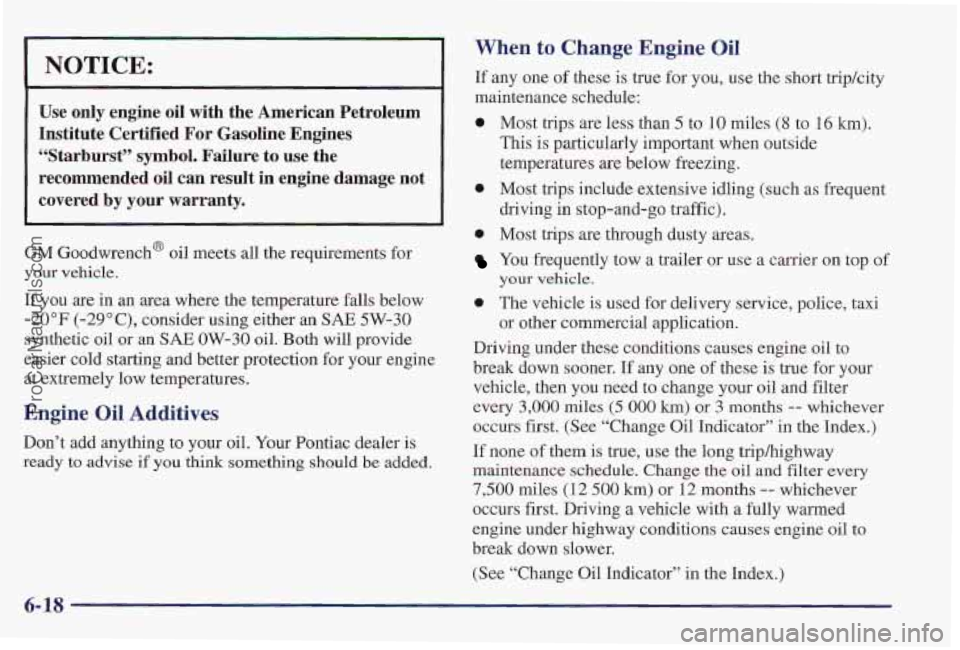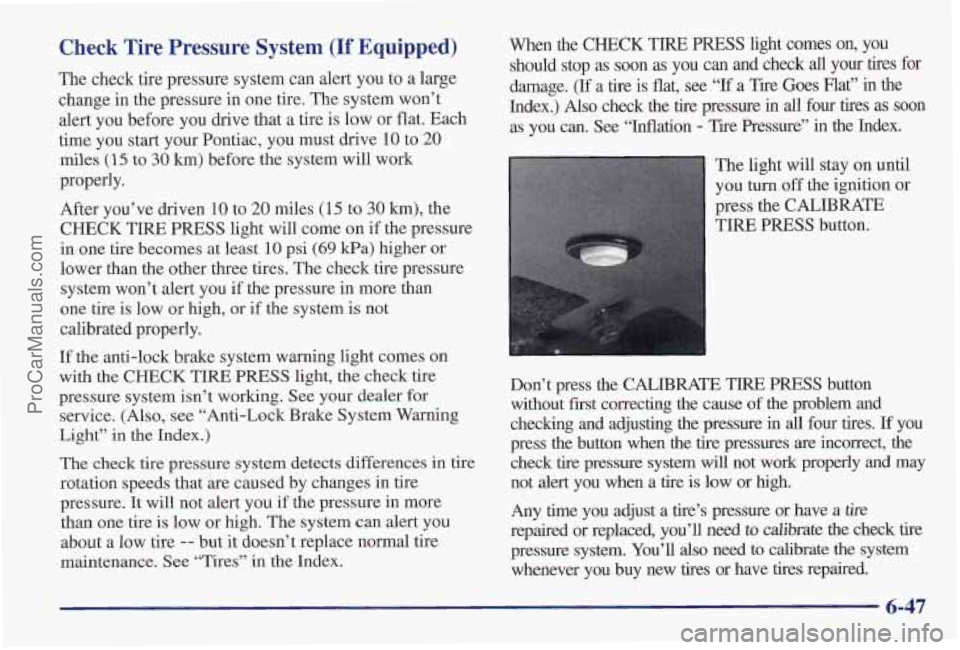stop start PONTIAC PONTIAC 1997 Owner's Manual
[x] Cancel search | Manufacturer: PONTIAC, Model Year: 1997, Model line: PONTIAC, Model: PONTIAC PONTIAC 1997Pages: 419, PDF Size: 19.67 MB
Page 232 of 419

Parking on Hills
You really should not park your vehicle, with a trailer
attached,
on a hill. If something goes wrong, your rig
could start to move. People
can be injured, and both
your vehicle and the trailer can be damaged.
But
if you ever have to park your rig on a hill, here’s
how to do it:
1. Apply your regular brakes, but don’t shift into
2. Have someone place chocks under the trailer wheels.
3. When the wheel chocks are in place, release the
regular brakes until the chocks absorb the load.
4. Reapply the regular brakes. Then apply your parking
brake, and then shift to
FARM (P).
5. Release the regular brakes.
PARK (P) yet,
When You Are Ready to Leave After
Parking on a Hill
1. Apply your regular brakes and hold the pedal down
while you:
Start your engine;
Shift into a gear; and
0 Release the parking brake.
2. Let up on the brake pedal.
3. Drive slowly until the trailer is clear of the chocks.
4. Stop and have someone pick up and store the chocks.
Maintenance When Trailer Towing
Your vehicle will need service more often when you’re
pulling
a trailer. See the Maintenance Schedule for more
on this. Things that are especially important in trailer
operation are automatic transaxle fluid (don’t overfill),
engine oil, belts, belt, cooling system and brake
adjustment. Each
of these is covered in this manual, and
the Index will
help you find them quickly. If you’re
trailering, it’s a good idea to review these sections
before you start your trip.
Check periodically to see that all hitch nuts and bolts
are tight.
4-38
ProCarManuals.com
Page 288 of 419

NOTICE:
Use only engine oil with the American Petroleum
Institute Certified For Gasoline Engines
“Starburst” symbol. Failure to use the
recommended oil can result in engine damage not
covered by
your warranty.
GM Goodwrench@ oil meets all the requirements for
your vehicle.
If you are in an area where the temperature falls below
-20°F (-29*C), consider using either an SAE 5W-30
synthetic oil or an SAE OW-30 oil. Both will provide
easier cold starting and better protection
for your engine
at extremely low temperatures.
Engine Oil Additives
Don’t add anything to your oil. Your Pontiac dealer is
ready
to advise if you think something should be added.
When to Change Engine Oil
If any one of these is true for you, use the short trip/city
maintenance schedule:
0 Most trips are less than 5 to 10 miles (8 to 16 km).
This
is particularly important when outside
temperatures are below freezing.
0 Most trips include extensive idling (such as frequent
driving in stop-md-go traffic).
0 Most trips are through dusty areas.
You frequently tow a trailer or use a carrier on top of
0 The vehicle is used for delivery s’ervice, police, taxi
Driving und’er these conditions causes engine oil to
break down sooner, If any one
of these is true €or your
vehicle, then you need to change your oil and filter
every
3,000 miles (5 000 km) or 3 months -- whichever
occurs first. (See “Change Oil Indicator” in the Index.)
If none of them is true, use the long triphighway
maintenance
schedule. Change th’e oil and filter every
7,500 miles (12 500 km) or 12 months -- whichever
occurs first, Driving
a vehicle with a fully warmed
engine under highway conditions causes engine oil
to
break down slower.
(See “Change Oil Indicator” in the Index.)
your vehicle.
or other commercial application,
6- 18
ProCarManuals.com
Page 317 of 419

Check Tire Pressure System (If Equipped)
The check tire pressure system can alert you to a large
change in the pressure in one tire. The system won’t
alert you before you drive that a tire is low or flat. Each
time you start your Pontiac, you must drive
10 to 20
miles (15 to 30 km) before the system will work
properly.
After you’ve driven
10 to 20 miles (15 to 30 km), the
CHECK TIRE PRESS light will come on if the pressure
in o’ne
tire becomes at least 10 psi (69 kPa) higher or
lower than the other three tires. The check tire pressure
system won’t alert you if the pressure in more than
one tire is low or high, or if the system is not
calibrated properly.
If the anti-lock brake system warning light comes on
with the
CHECK TIRE PRESS light, the check tire
pressure system isn’t working. See your dealer for
service. (Also, see “Anti-Lock Brake System Warning
Light” in
the Index.)
The check tire pressure system detects differences in tire
rotation speeds that are caused by changes in tire
pressure. It will not alert you if the pressure in more
than one tire is low or high. The system can alert you
about
a low tire -- but it doesn’t replace normal tire
maintenance. See “Tires” in
the Index. When
the CHECK
TIRE PRESS light comes on, you
should stop as soon
as you can and check all your tires for
darnage. (If a tire
is flat, see “If a Tire Goes Flat” in the
Index.) Also check the tire pressure in all four tires as soon
as you can. See “Inflation - Tire Pressure” in the Index.
The light will stay on until
you turn off the ignition
or
press the CALIBRATE
TIRE
PRESS button.
Don’t press the CALIBRATE TIRE
PRESS button
without first correcting the cause of the problem and
checking and adjusting the pressure in all four tires.
If you
press the button when the tire pressures
are incorrect, the
check tire pressure system will not work properly
and may
not alert you when a tire is low or high.
Any time you adjust a tire’s pressure or have a
tire
repaired or replaced, you’ll need to calibrate the check tire
pressure system. You’ll
also need to calibrate the system
whenever you buy new tires or have
tires repaired.
6-47
ProCarManuals.com